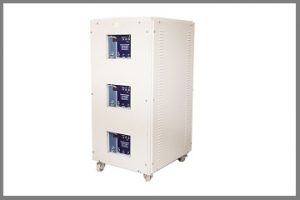“Servottam” Isolation Transformer is used to transfer electrical power from a source of alternating current (AC) power to some equipment or device while isolating the powered device from the power source, usually for safety reasons. “Servottam” Isolation transformer provides galvanic isolation and are used to protect against electric shock, to suppress electrical noise in sensitive devices, or to transfer power between two circuits which must not be connected. A transformer sold for isolation is often built with special insulation between primary and secondary, and is specified to withstand a high voltage between windings.
“Servottam” Isolation Transformers block transmission of the DC component in signals from one circuit to the other, but allow AC components in signals to pass. Transformers that have a ratio of 1 to 1 between the primary and secondary windings are often used to protect secondary circuits and individuals from electrical shocks between energized conductors and earth ground. Suitably designed isolation transformers block interference caused by ground loops. Isolation transformers with electrostatic shields are used for power supplies for sensitive equipment such as Online UPS, computers, medical devices, or laboratory instruments, automotive components machines, imported machines etc.
“Servottam” Isolation Transformer Terminology
Sometimes the term is used to emphasize that a device is not an autotransformer whose primary and secondary circuits are connected. Power transformers with specified insulation between primary and secondary are not usually described only as "isolation transformers" unless this is their primary function. Only transformers whose primary purpose is to isolate circuits are routinely described as isolation transformers.
“Servottam” Isolation Transformer Operation
“Servottam” Isolation transformers are designed with attention to capacitive coupling between the two windings. The capacitance between primary and secondary windings would also couple AC current from the primary to the secondary. A grounded Faraday shield between the primary and the secondary greatly reduces the coupling of common-mode noise.

